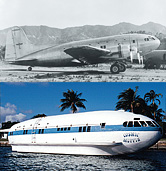![]()
 |
|||||||||
| Flying
the Friendly Seas
How one man took a 1939 Boeing 307 Stratoliner from soaring high in the blue skies to cruising along the deep blue sea. By Elizabeth Ginns Britten — September 2004 |
|||||||||
It’s not everyday you see one of these cruise through the harbor—or docked at the local marina. That’s because Cosmic Muffin, the “boat” you see in the photo on the right, is a true one of a kind: At one time, she was a 1939 Boeing 307 Stratoliner airplane complete with wings, tail, and cockpit, and she actually flew. (The 307 was the first commercial pressurized aircraft and a variant of the B-17 Flying Fortress. Only ten 307s were built, all in the late-1930’s. Production was stopped at the outbreak of war in Europe in September 1939.) For more than 20 years, Cosmic Muffin was a houseboat for her proud liveaboard owner, David Drimmer. Today she rests dockside in Fort Lauderdale, Florida, open to the public for touring or chartering. But the story of how she came to be what she is today is even weirder than her looks. It all began when industrialist and aviation pioneer Howard Hughes acquired the plane in 1939 as part of his purchase of Trans World Airlines (TWA). Ten years later Texas oil baron Glenn McCarthy, who’s life was immortalized by James Dean in the movie Giant, purchased the plane, which he dubbed The Shamrock. In 1962 the plane arrived in Fort Lauderdale, and Florida Jet Research bought it. Then in 1964 the plane suffered extensive damage from Hurricane Cleo, ending its flying days. Drimmer says its then-owner, aircraft broker Joseph MacCaughtry, who bought the plane sometime around 1963 or 1964, took a $40,000 loan out to fix it, then defaulted, after which the bank removed everything of value—engines included. “From then until 1969 it was left derelict, abandoned, open, and unlocked...people would come aboard and lounge around,” Drimmer reports. Later that year the airplane was declared abandoned property and put up for auction. Ken London, a private pilot, came in with the winning bid: a whopping $62. Drimmer says, “He [London] thought, ‘What can we do besides cutting it all up?’ That’s when he came up with the wacky idea of making it into a motoryacht.” And so, after some extensive work that included removing the wings and tail with an acetylene torch, London took the remaining fuselage to a nearby boatyard. In 1974 he launched the former 307 as a seaworthy vessel dubbed The Londonaire. Herb Werner purchased the vessel in 1977 for $60,000, under an agreement whereby, according to Drimmer, Werner would make payments and give London a Ford Thunderbird. Only London never got either—luckily for him, he never signed over the title. Allegedly, the boat was in a yard for a refit when Werner suffered a massive heart attack and died on the operating table. His estate abandoned the vessel, and the yard doing the refit work took possession of it. When no one would pay the $12,000 yard bill, it was again put up for auction. In 1981, after receiving no bids, the yard put an ad in the local classifieds, promoting the plane-boat as a “unique 56-foot houseboat. A true ‘bachelor pad.’ For sale for $8,500.” Drimmer, who at the time was renting an apartment in the area, was looking for a new place and came across the ad. He says, “I was looking for something livable and affordable, and this sounded good. When I saw it, I said, ‘Holy crap! It’s a floating plane!’” Drimmer, who had no marine background, decided he just “had to have it,” and $7,500 later, it was all his. “Everybody thought I was crazy when I said I wanted to buy it,” Drimmer, who earns a modest salary working in the printing industry, told me during a phone interview. “A friend of mine with an extensive nautical background who was helping me shop for a liveaboard boat begged me not to buy it, my Mom begged me not to buy it, my lawyer begged me not to buy it, but I just had to have it...I found the tubular look and shape terribly intriguing and fascinating; it was a very welcoming, open kind of warmth, and I could see beyond the mess and enjoy the novelty of what it really was.” After a pause and a chuckle, he adds, “It’s funny. Rich people that do something like that get called ‘eccentric’; poor people are ‘crazy.’” Next page > Part 2: “I’ve finally learned the secret of boat repairs: Do your estimate, crunch your numbers, and whatever figure you come up with, double it.” > Page 1, 2, 3, 4 |





